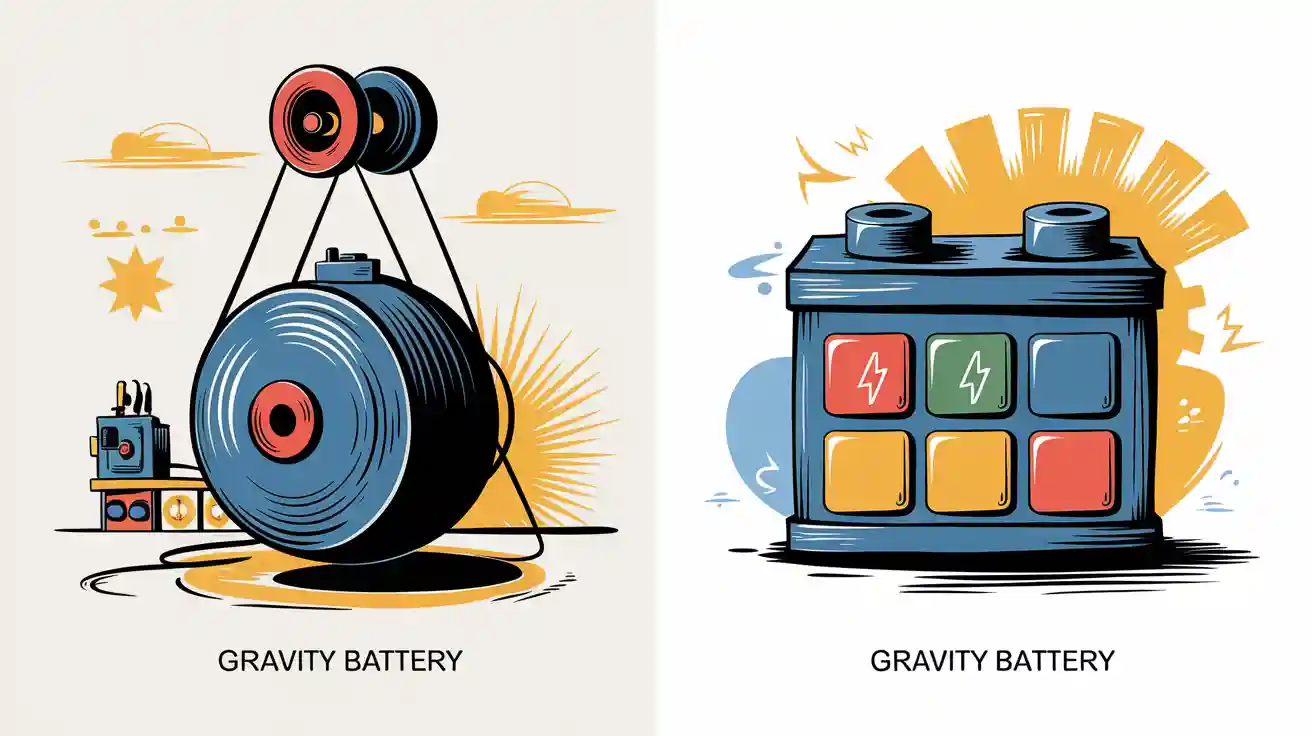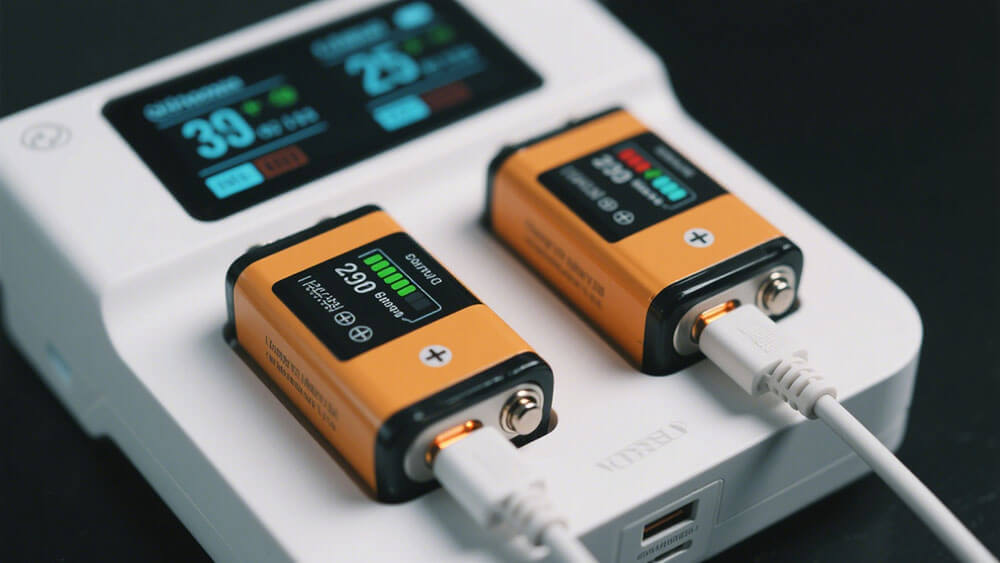
Energy storage technology plays a vital role in modern power systems. You encounter two distinct approaches: gravity batteries and traditional batteries. Gravity batteries store energy by leveraging gravitational potential, while traditional batteries rely on chemical reactions. This fundamental difference drives variations in efficiency, scalability, and environmental impact. For renewable energy projects, understanding the trade-offs in a gravity battery vs traditional battery comparison is crucial.
Key Takeaways
Gravity batteries store energy using gravity, so they last longer and don’t wear out quickly.
Regular batteries, like lithium-ion ones, are great for portable devices because they hold a lot of energy but need replacing often.
For green energy projects, gravity batteries store energy for a long time and are eco-friendly, while regular batteries work better for small, tight spaces.
Part 1: What Are Gravity Batteries?

1.1 How Gravity Energy Storage Works
Gravity energy storage operates by utilizing gravitational potential energy. This system raises and lowers heavy objects, such as solid materials or water, to store and release energy. When surplus electricity is available, the system lifts these objects, converting electrical energy into stored gravitational potential energy. Later, when energy demand increases, the objects are lowered, and the released energy drives generators to produce electricity.
The functionality of gravity energy storage has been validated through advanced mathematical modeling and simulation tools like Simulink. These simulations measure critical parameters, including duty cycle time, piston position, and system power. Experimental results confirm that simulated models closely mimic real-world operations with minimal errors.
Key Component | Description |
|---|---|
Energy Storage Principle | Utilizes gravitational potential energy by lifting heavy objects. |
Validation Method | Mathematical modeling and simulation using Simulink. |
Important Parameters | Duty cycle time, piston position, chambers pressure and volume, system power and capacity. |
Experimental Results | Simulated model successfully mimics real model operation with minimal errors. |
1.2 Key Features of Gravity Batteries
Gravity batteries offer several unique features that set them apart from traditional energy storage technology. First, they rely on simple mechanical systems, making them highly durable and less prone to degradation over time. Unlike chemical batteries, gravity energy storage systems do not lose capacity with repeated use.
Another key feature is their scalability. These systems can be designed for small-scale applications or expanded to store massive amounts of energy for grid-scale use. Additionally, gravity batteries have minimal environmental impact. They do not involve hazardous chemicals or rare materials, making them a sustainable choice for energy storage.
Gravity energy storage technology also excels in long-term energy retention. Once the energy is stored, it can remain available for extended periods without significant losses. This makes gravity batteries ideal for balancing renewable energy sources like wind and solar, which often produce intermittent power.
Part 2: What Are Traditional Batteries?

2.1 Types of Traditional Batteries
Traditional batteries are categorized based on their chemical composition and application. The global battery market, valued at approximately USD 134.6 billion in 2024, is projected to grow at a compound annual growth rate (CAGR) of 16.4% from 2025 to 2030. This growth is driven by the increasing adoption of electric vehicles and renewable energy integration into power grids.
Mobility Batteries: Designed for electric vehicles and transportation systems, these batteries prioritize energy density and cycle life.
Stationary Batteries: Used in grid storage and backup systems, they focus on scalability and long-term reliability.
Portable Batteries: Found in consumer electronics, these batteries emphasize compactness and lightweight design.
Battery Type | Specific Energy (Wh/kg) | Cycle Durability (cycles) | Nominal Cell Voltage (V) |
|---|---|---|---|
Lead-Acid | 35–40 | <350 | 2.1 |
Nickel-Cadmium (NiCd) | 40–60 | 2000 | 1.2 |
Lithium-Ion | High | Varies | Varies |
2.2 How Lithium-Ion Batteries Work
Lithium-ion batteries, a cornerstone of modern energy storage, operate through the movement of lithium ions between the anode and cathode. During charging, lithium ions migrate from the cathode to the anode via an electrolyte. When discharging, the ions flow back to the cathode, generating electricity.
Scientific studies highlight critical factors influencing lithium-ion battery performance:
Observations | Description |
|---|---|
Lithium concentration | Balancing cathode and anode materials ensures long-term stability. |
Reaction mechanisms | Charge and discharge processes exhibit distinct kinetics. |
Non-equilibrium reactions | High current drain triggers unique reactions in electrodes. |
Structural relaxation | High current conditions impact commercial cell performance. |
2.3 Key Features of Lithium-Ion Batteries
Lithium-ion batteries offer several advantages that make them indispensable across industries. Their high energy density supports applications requiring compact and lightweight designs, such as consumer electronics. Additionally, they exhibit excellent cycle durability, with some variants lasting up to 2000 cycles.
Performance metrics further validate their reliability:
Lithium-ion batteries also align with sustainability goals. Unlike older technologies, they contain fewer toxic materials, reducing environmental impact. For businesses seeking tailored solutions, custom battery solutions can optimize performance for specific applications.
Part 3: Key Differences in Energy Storage Mechanisms

3.1 Gravity Energy Storage vs Chemical Energy Storage
The fundamental difference between gravity energy storage and chemical energy storage lies in their operating principles. Gravity energy storage systems rely on gravitational potential energy, achieved by raising and lowering heavy objects. In contrast, traditional batteries store energy through electrochemical reactions within their cells.
Feature | Gravity Battery | Traditional Battery |
|---|---|---|
Energy Storage Method | Gravitational potential | Electrochemical reactions |
Energy Density (Wh/kg) | ~20–30 Wh/kg | Lead-Acid: ~30–50 Wh/kg; Lithium-Ion: ~150–250 Wh/kg |
Cycle Life | Potentially unlimited | Lead-Acid: ~500 cycles; Lithium-Ion: ~500-2000 cycles |
Cost per kWh Stored | ~$100-$200 | Lead-Acid: ~$150; Lithium-Ion: ~$300-$600 |
Environmental Impact | Minimal | Variable; depends on materials used |
The lower energy density of gravity energy storage systems makes them unsuitable for portable applications. However, their unlimited cycle life and minimal environmental impact provide significant advantages for large-scale, stationary energy storage systems. Traditional batteries, particularly lithium-ion batteries, excel in applications requiring high energy density, such as consumer electronics and electric vehicles.
3.2 Efficiency and Scalability
Gravity energy storage systems demonstrate remarkable efficiency and scalability, especially for grid-scale applications. These systems can operate for 20–30 years with minimal performance degradation, offering consistent energy storage efficiency over time. Unlike chemical batteries, gravity batteries require less maintenance and are less prone to unexpected failures during outages.
Traditional batteries, while efficient in smaller-scale applications, face challenges in scalability. Lithium-ion batteries, for instance, degrade over time and require frequent replacements, increasing long-term costs. Gravity energy storage power generation, on the other hand, can reduce electricity bills by 30–40% by storing excess solar energy for later use. This makes gravity batteries a cost-effective solution for renewable energy integration and large-scale infrastructure projects.
3.3 Environmental Impact
The environmental impact of energy storage systems varies significantly between gravity and traditional batteries. Gravity batteries have a minimal environmental footprint, as they do not rely on hazardous chemicals or rare materials. Their mechanical components are also easier to recycle, further enhancing their sustainability.
In contrast, traditional batteries, particularly lithium-ion batteries, involve complex manufacturing processes that contribute to higher emissions. For example:
Aluminum alloy battery casings have the lowest overall environmental impact but account for 88.3% of lifecycle CO2 emissions during production.
Recycling can mitigate these emissions, but the primary environmental burden remains during the material stage.
The advantages of gravity batteries in terms of sustainability make them an ideal choice for businesses prioritizing eco-friendly energy storage solutions. For more insights into sustainable practices, explore sustainability at Large Power.
3.4 Cost and Maintenance
Cost and maintenance are critical factors when comparing gravity energy storage systems and traditional batteries. Gravity batteries have a lower cost per kWh stored, ranging from $100 to $200, compared to $300–$600 for lithium-ion batteries. Their simple mechanical design reduces maintenance requirements, further lowering operational costs.
Traditional batteries, while initially more affordable for small-scale applications, incur higher long-term costs due to frequent replacements and maintenance. The economic benefits of gravity energy storage become evident in large-scale projects, where their durability and low maintenance needs translate into significant savings.
If you’re considering tailored energy storage solutions for your business, explore custom battery solutions to optimize performance and cost-efficiency.
Part 4: Comparing Applications of Gravity Batteries and Traditional Batteries

4.1 Industrial and Grid-Scale Applications
Gravity energy storage systems excel in industrial and grid-scale applications due to their scalability and durability. These systems are particularly effective for balancing energy supply and demand in large-scale infrastructure projects. By storing excess energy during low-demand periods and releasing it during peak hours, gravity batteries help stabilize power grids and reduce reliance on fossil fuels. Their ability to operate for decades with minimal maintenance makes them a cost-effective solution for long-term energy storage.
In contrast, the applications of traditional batteries in industrial settings often face limitations. While lithium-ion batteries are widely used for grid storage, their capacity degrades over time, requiring frequent replacements. This increases operational costs and poses challenges for large-scale projects. However, the high energy density of lithium-ion batteries makes them suitable for specific industrial applications requiring compact energy storage solutions.
Feature | Gravity Batteries | Traditional Batteries (e.g., Lithium-Ion) |
|---|---|---|
Scalability | High; ideal for grid-scale applications | Moderate; limited by capacity degradation |
Maintenance Requirements | Low; mechanical systems are durable | High; frequent replacements needed |
Suitability for Infrastructure | Excellent; supports long-term projects | Limited; better for short-term use cases |
Tip: If your business operates in the industrial sector, consider gravity energy storage for its low cost and long-term reliability. For tailored solutions, explore custom battery solutions.
4.2 Commercial and Portable Applications
The applications of traditional batteries dominate the commercial and portable energy storage market. Lithium-ion batteries, for instance, power a wide range of consumer electronics, including smartphones, laptops, and medical devices. Their high energy density and lightweight design make them indispensable for portable applications. However, the disadvantages of traditional batteries, such as limited cycle life and environmental concerns, remain significant challenges.
Gravity energy storage systems, on the other hand, are less suited for portable applications due to their lower energy density and reliance on large mechanical components. However, they can be adapted for commercial use in scenarios where space and weight are not constraints. For example, businesses with renewable energy installations can use gravity batteries to store surplus energy and reduce electricity costs.
Application Type | Gravity Batteries | Traditional Batteries (e.g., Lithium-Ion) |
|---|---|---|
Portable Devices | Not suitable | Ideal; high energy density |
Commercial Energy Storage | Effective for stationary systems | Suitable for smaller-scale setups |
Environmental Impact | Minimal | Higher; depends on materials used |
Note: For businesses in the consumer electronics sector, lithium-ion batteries remain the preferred choice. Learn more about their applications here.
4.3 Renewable Energy Integration
Renewable energy integration represents one of the most promising applications of gravity batteries. These systems can store energy generated by solar panels or wind turbines during peak production periods and release it when demand increases. Their ability to retain energy for extended periods without significant losses makes them ideal for balancing the intermittent nature of renewable energy sources.
Traditional batteries, such as lithium-ion, also play a crucial role in renewable energy systems. Their compact design and high capacity make them suitable for residential solar installations and small-scale wind energy projects. However, the disadvantages of traditional batteries, including their environmental impact and limited lifespan, can hinder their long-term sustainability.
Feature | Gravity Batteries | Traditional Batteries (e.g., Lithium-Ion) |
|---|---|---|
Energy Retention | Long-term; minimal losses | Shorter-term; capacity degrades over time |
Suitability for Renewables | Excellent; supports grid-scale systems | Good; ideal for residential setups |
Sustainability | High; eco-friendly materials | Moderate; recycling mitigates impact |
Callout: If your business prioritizes sustainability, gravity energy storage offers a greener alternative for renewable energy integration. For more insights, explore sustainability at Large Power.
Gravity batteries and traditional batteries fulfill unique roles in energy storage. You should consider gravity batteries for large-scale, long-term applications like grid stabilization or renewable energy storage. Their durability and minimal environmental impact make them ideal for infrastructure projects.
Traditional batteries, especially lithium-ion variants, excel in portable and high-energy-density applications. They power consumer electronics, medical devices, and robotics with unmatched efficiency. However, their environmental footprint and maintenance needs require careful evaluation.
To choose the right solution, assess your electricity storage requirements, cost constraints, and sustainability goals. Large Power offers tailored solutions to optimize performance and meet your operational priorities. Explore custom battery solutions for expert guidance.
FAQ
1. What makes gravity energy storage more sustainable than traditional batteries?
Gravity energy storage avoids hazardous chemicals and rare materials. Its mechanical components are easier to recycle, reducing environmental impact significantly.
2. Can gravity batteries replace traditional batteries in portable applications?
No, gravity batteries lack the energy density required for portable devices. Traditional batteries, like lithium-ion, remain the best choice for compact energy storage.
3. How do you decide between gravity battery vs traditional battery for renewable energy projects?
Choose gravity batteries for grid-scale systems and long-term storage. Opt for traditional batteries for residential setups or smaller renewable energy applications.




